-
Paper Information
- Paper Submission
-
Journal Information
- About This Journal
- Editorial Board
- Current Issue
- Archive
- Author Guidelines
- Contact Us
American Journal of Mathematics and Statistics
p-ISSN: 2162-948X e-ISSN: 2162-8475
2017; 7(5): 209-225
doi:10.5923/j.ajms.20170705.03

A Comparison of Exponential Type Mean Estimators in Two Phase Sampling
Özge Akkuş
Department of Statistics, Muğla Sıtkı Koçman University, Muğla, Turkey
Correspondence to: Özge Akkuş, Department of Statistics, Muğla Sıtkı Koçman University, Muğla, Turkey.
| Email: |  |
Copyright © 2017 Scientific & Academic Publishing. All Rights Reserved.
This work is licensed under the Creative Commons Attribution International License (CC BY).
http://creativecommons.org/licenses/by/4.0/

In this study, exponential type mean estimators in two phase sampling method are introduced. Bias and mean square error equations are derived. All the studied estimators are listed chronologically. In order to compare the efficiencies of the estimators, data on table olive production taken from Turkish Statistical Institute from 287 regions of Turkey in 2010 are used. Mean value, mean square error values and relative efficiency values are calculated. The best and the worst estimators are determined.
Keywords: Two Phase Sampling, Exponential Estimator, Ratio Estimator, Product Estimator, Relative Efficiency, Bias, Mean Square Error
Cite this paper: Özge Akkuş, A Comparison of Exponential Type Mean Estimators in Two Phase Sampling, American Journal of Mathematics and Statistics, Vol. 7 No. 5, 2017, pp. 209-225. doi: 10.5923/j.ajms.20170705.03.
Article Outline
1. Introduction
- When we want to estimate the population mean of N units, the study variable Y can be explained better by using the auxiliary variable X. However, in some studies, the population information of auxiliary variable X may not be accessible. In this case, two phase sampling method is used.The aim of this method is to estimate the population information of the auxiliary variable X in the first phase in the most efficient way and reach the most efficient estimates of the population parameters of variable Y via selected sub-sample in the second phase.If population information of the auxiliary variable X cannot be reached, a sample is selected in order to estimate the information of variable X in the first phase of the sampling method which takes place in two phases. In the first phase, the sample selected with Simple Random Sampling (SRS) without replacement is called the primary sample and is composed of
 units.In some cases, information on variable X can be obtained using a second auxiliary variable (Z). In this case, X and Z variables are observed in the primary sample. In the first phase, the necessary information for variable X is estimated and passed to the second phase. In the second phase, the population mean of the variable Y is estimated with the aid of the information of the auxiliary variable X obtained in the first phase. For this purpose, the sample drawn from primary sample with SRS without replacement is called a sub-sample and consists of n units
units.In some cases, information on variable X can be obtained using a second auxiliary variable (Z). In this case, X and Z variables are observed in the primary sample. In the first phase, the necessary information for variable X is estimated and passed to the second phase. In the second phase, the population mean of the variable Y is estimated with the aid of the information of the auxiliary variable X obtained in the first phase. For this purpose, the sample drawn from primary sample with SRS without replacement is called a sub-sample and consists of n units  ([12], [7]). The most important point to note in sample selection is sample size. Decisions about how large the size of both samples should have a significant impact on the efficiencies of estimates. The sub-sample size should not exceed the primary sample size. The larger the primary sample, the greater the efficiencies of the predictions. Therefore, the size of the samples, sampling method and estimators to be used are very important in terms of the efficiency and accuracy of the estimates both in the selection of primary and sub-samples.In this study, the primary and sub-samples are selected with SRS without replacement.In two phase sampling method, there are ratio, product, regression and exponential types estimators. The ratio estimator is used when the correlation between the study variable Y and the auxiliary variable X is directly proportional; product estimator when it is inversely proportional and the regression estimator is used when it can be obtained from a different point from the origin. When there is a curvilinear relationship between variables, it is observed that using exponential estimators gives more efficient results [1].In this study, exponential type mean estimators in two phase sampling method are investigated. The equations of Bias and Mean Square Error (MSE) of all estimators that are subject to the study and the theoretical proofs are derived. In the application part of the study, the table olive production data taken from Turkish Statistical Institute obtained from 287 regions of Muğla province of 2010 are used. Bias, MSE and Relative Efficiency (RE) values are calculated. Estimators are compared with each other and the most efficient and worst estimator for the data set used is reached.
([12], [7]). The most important point to note in sample selection is sample size. Decisions about how large the size of both samples should have a significant impact on the efficiencies of estimates. The sub-sample size should not exceed the primary sample size. The larger the primary sample, the greater the efficiencies of the predictions. Therefore, the size of the samples, sampling method and estimators to be used are very important in terms of the efficiency and accuracy of the estimates both in the selection of primary and sub-samples.In this study, the primary and sub-samples are selected with SRS without replacement.In two phase sampling method, there are ratio, product, regression and exponential types estimators. The ratio estimator is used when the correlation between the study variable Y and the auxiliary variable X is directly proportional; product estimator when it is inversely proportional and the regression estimator is used when it can be obtained from a different point from the origin. When there is a curvilinear relationship between variables, it is observed that using exponential estimators gives more efficient results [1].In this study, exponential type mean estimators in two phase sampling method are investigated. The equations of Bias and Mean Square Error (MSE) of all estimators that are subject to the study and the theoretical proofs are derived. In the application part of the study, the table olive production data taken from Turkish Statistical Institute obtained from 287 regions of Muğla province of 2010 are used. Bias, MSE and Relative Efficiency (RE) values are calculated. Estimators are compared with each other and the most efficient and worst estimator for the data set used is reached.2. Literature Review
- The first classical ratio and product estimator in the two phase sampling method was proposed by [18]. [15] proposed a new ratio and product estimator by adapting their proposed ratio and product estimators in SRS to the two phase sampling method. [12] proposed new ratio and product type exponential estimators in two phase sampling method, inspired by the ratio and product type exponential estimators proposed by [2] in SRS.[17] proposed a new estimator by adapting their estimator to two phase sampling method in the form of a combination of ratio and product estimators proposed by [2] in SRS.Inspired by ratio and product type exponential estimators proposed by [2] in SRS, [13] proposed a new exponential estimator class by adapting their proposed estimator class in SRS to the two phase sampling plan.[16] proposed two new estimators, adapting the estimator they proposed in SRS to two phase sampling method.[23] proposed new ratio-exponential and product-exponential estimators in two phase sampling method, inspired by the estimators of [8] and [4].[9] proposed a chain-type ratio and chain type product exponential estimators using second variable information in two phase sampling method following the ratio and product type exponential estimators proposed by [12].[6] proposed ratio-cum-product and chain-type ratio exponential estimators using two auxiliary variable information.[22] proposed a chain-ratio type exponential family of estimator based on the ratio and product estimators using two auxiliary variables in estimating the population mean proposed by [12] in two phase sampling method. [10] proposed a class of chain-ratio and product type exponential estimators in the form of a combination of their proposed chain ratio and chain product type exponential estimators in two phase sampling.[5] proposed new chain-ratio and chain-product type exponential estimators based on their proposed chain-ratio and chain-product type exponential estimators in two phase sampling.[11] proposed three new chain-type exponential estimators inspired by the estimators of [2] in SRS and [12] in two phase sampling.[19] proposed a class of chain-ratio type exponential estimator for the estimation of population mean using two-auxiliary-variable information in two phase sampling.[20] proposed a class of chain-ratio-product type exponential estimator for the estimation of population mean using two-auxiliary-variable information in two phase sampling.[21] proposed a new class of chain-ratio-product type exponential estimator in estimating population mean using two-auxiliary-variable-information in two phase sampling.Inspired by [2] and [3] estimators, [14] proposed chain- ratio and chain-product type exponential estimators in the case of two auxiliary variables in two phase sampling for the estimation of the population mean.
3. Exponential Type Mean Estimators in Two Phase Sampling
- The list of exponential type mean estimators in two phase sampling in current literature, Mean Square Error (MSE) and Bias equations are presented in Table 1.
 | Table 1. The Chronological Order of the Exponential Type Mean Estimators in Two Phase Sampling |
 | Table 1. (continued) |
 and
and  ) are defined, respectively as follows.
) are defined, respectively as follows. | (3.1) |
 | (3.2) |
 | (3.3) |
 | (3.4) |
 | (3.5) |
 | (3.6) |
 | (3.7) |
 | (3.8) |
 | (3.9) |
 | (3.10) |
 | (3.11) |
 | (3.12) |
 ,
,  and
and  are defined as follows.
are defined as follows. | (3.13) |
 | (3.14) |
 | (3.15) |
 ,
,  and
and  are given by Eq.(3.16), Eq.(3.17) and Eq.(3.18), respectively.
are given by Eq.(3.16), Eq.(3.17) and Eq.(3.18), respectively.  | (3.16) |
 | (3.17) |
 | (3.18) |

4. Application
- In this part of the study, to compare the efficiencies of exponential type mean estimators proposed in two phase sampling in the literature, data on table olive production taken from Turkish Statistical Institute in 287 regions of Muğla province in 2010 are used.The definitions of the study variable Y and auxiliary variables X and Z are given below [24].X: Amount of table olive produced (Ton) Y: Number of fruit trees Z: Area of bulk fruits (Decar)The average number of trees in the fruiting age
 is estimated using the knowledge of the area of the collective fruit trees. The main aim of this study is to estimate the average table olive production
is estimated using the knowledge of the area of the collective fruit trees. The main aim of this study is to estimate the average table olive production  in the most efficient way, where the population unit is regions.The primary and sub-samples are drawn with the SRS method without replacement.The primary sample size to be drawn from the population (N = 287) by the SRS method when the amount of error that can be tolerated is d = 300,
in the most efficient way, where the population unit is regions.The primary and sub-samples are drawn with the SRS method without replacement.The primary sample size to be drawn from the population (N = 287) by the SRS method when the amount of error that can be tolerated is d = 300,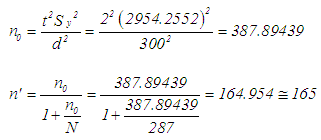 If the amount of error that can be tolerated for the sub-sample size to be selected from the primary sample with n = 165 is taken as d = 300, the sub-sample size to be selected with the SRS method is,
If the amount of error that can be tolerated for the sub-sample size to be selected from the primary sample with n = 165 is taken as d = 300, the sub-sample size to be selected with the SRS method is, For the population and selected sample, the values in the following tables are observed. The values of Bias, MSE and RE of all exponential mean estimators subject to the study and theoretical proofs are calculated on the basis of the these values.The population information obtained for table olive production, the primary sampling data and the sub-sample information is given in Table 2, Table 3 and Table 4, respectively.Table 5 shows the variables used when estimating Bias, MSE and RE values of the proposed estimators.In order to compare the efficiency of the exponential mean estimators proposed in the two phase sampling method, Bias, MSE and RE values calculated based on the average table olive production are given in Table 6. From these estimators, in which the MSE value is the lowest estimator is the most efficient estimator.Exponential mean estimators are listed in chronological order in the two phase sampling in Table 6. When the table is examined, it is observed that most of the proposed estimators give more efficient results than the classical ratio and product estimators.When the efficiencies of the estimators are compared based on the MSE values, the most efficient estimator for estimating the average table olive production is "Kalita, Singh and Choundhury Ratio Estimator-2" with 4914.57 MSE value; the second most efficient estimator is "Yadav, Upadayaya, Singh and Chatterer Estimator"; while the worst estimator is the "Sukhatme Classical Product Estimator" with 196422.23 MSE value.The RE-1 values in Table 6 are calculated according to the classical ratio estimator. When these values are examined, it is observed that "Kalita, Singh and Choundhury Ratio Estimator-2" is 10.04 times efficient than the classical ratio estimator; “Yadav, Upadayaya, Singh and Chatterer Estimator” is 2.77 times higher than the classical ratio estimator and "Sukhatme Classic Product Estimator" is 0.25 times more efficient than the classical ratio estimator.RE-2 values are calculated according to the classical product estimator. When these values are examined, it is revealed that "Kalita, Singh and Choundhury Ratio Estimator-2" is 39.97 times and "Yadav, Upadayaya, Singh and Chatterer Estimator" is observed to be 11.02 times more efficient than the classical product estimator.RE-3 values are calculated according to the mean-per-unit estimator (
For the population and selected sample, the values in the following tables are observed. The values of Bias, MSE and RE of all exponential mean estimators subject to the study and theoretical proofs are calculated on the basis of the these values.The population information obtained for table olive production, the primary sampling data and the sub-sample information is given in Table 2, Table 3 and Table 4, respectively.Table 5 shows the variables used when estimating Bias, MSE and RE values of the proposed estimators.In order to compare the efficiency of the exponential mean estimators proposed in the two phase sampling method, Bias, MSE and RE values calculated based on the average table olive production are given in Table 6. From these estimators, in which the MSE value is the lowest estimator is the most efficient estimator.Exponential mean estimators are listed in chronological order in the two phase sampling in Table 6. When the table is examined, it is observed that most of the proposed estimators give more efficient results than the classical ratio and product estimators.When the efficiencies of the estimators are compared based on the MSE values, the most efficient estimator for estimating the average table olive production is "Kalita, Singh and Choundhury Ratio Estimator-2" with 4914.57 MSE value; the second most efficient estimator is "Yadav, Upadayaya, Singh and Chatterer Estimator"; while the worst estimator is the "Sukhatme Classical Product Estimator" with 196422.23 MSE value.The RE-1 values in Table 6 are calculated according to the classical ratio estimator. When these values are examined, it is observed that "Kalita, Singh and Choundhury Ratio Estimator-2" is 10.04 times efficient than the classical ratio estimator; “Yadav, Upadayaya, Singh and Chatterer Estimator” is 2.77 times higher than the classical ratio estimator and "Sukhatme Classic Product Estimator" is 0.25 times more efficient than the classical ratio estimator.RE-2 values are calculated according to the classical product estimator. When these values are examined, it is revealed that "Kalita, Singh and Choundhury Ratio Estimator-2" is 39.97 times and "Yadav, Upadayaya, Singh and Chatterer Estimator" is observed to be 11.02 times more efficient than the classical product estimator.RE-3 values are calculated according to the mean-per-unit estimator ( ). When these values are examined, it is found that "Kalita, Singh and Choundhury Proportional Estimator-2" is 10.57 times; "Yadav, Upadayaya, Singh and Chatterter Estimator" is 2.91 times and "Sukhatme Classic Product Estimator" is 0.26 times more efficient than mean-per-unit estimator.
). When these values are examined, it is found that "Kalita, Singh and Choundhury Proportional Estimator-2" is 10.57 times; "Yadav, Upadayaya, Singh and Chatterter Estimator" is 2.91 times and "Sukhatme Classic Product Estimator" is 0.26 times more efficient than mean-per-unit estimator. | Table 2. Population Information Related to the Table Olive Production Data |
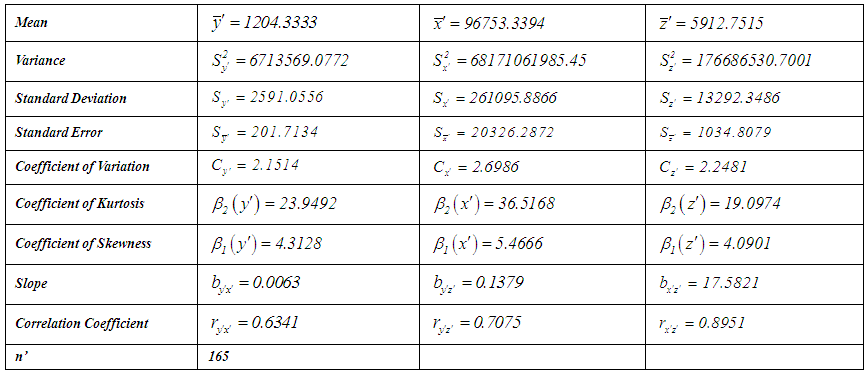 | Table 3. Primary Sample Information Related to the Table Olive Production Data |
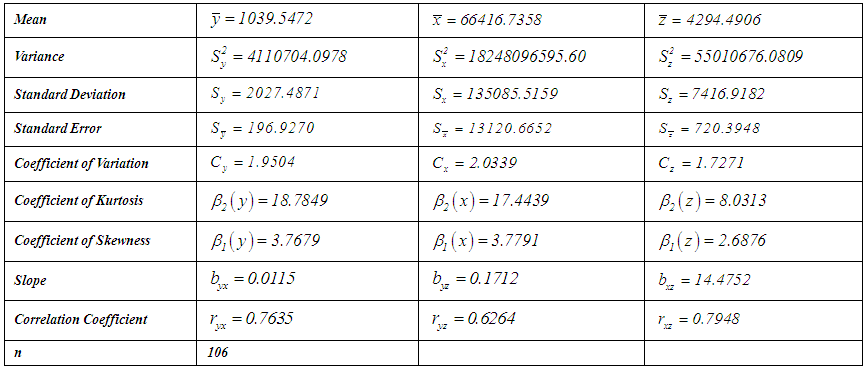 | Table 4. Sub-Sample Information Related to the Table Olive Production Data |
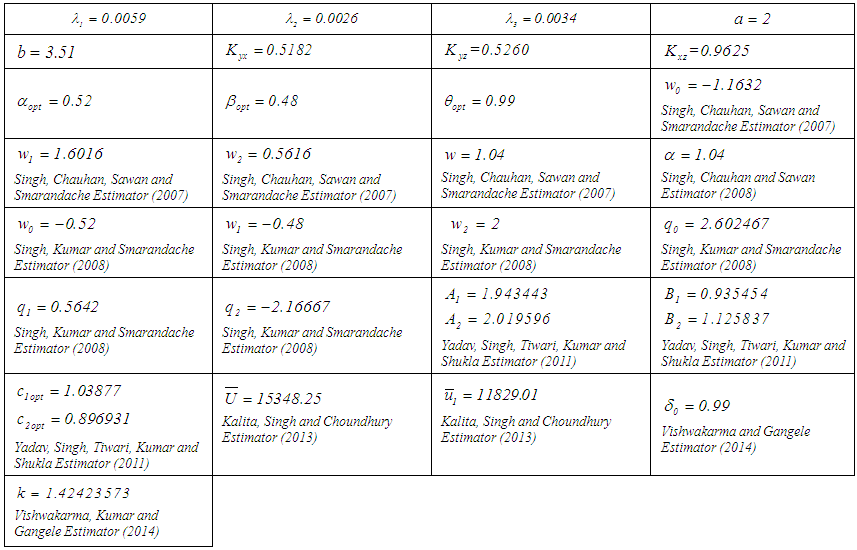 | Table 5. Some Parameter Values Related to the Proposed Exponential Estimators |
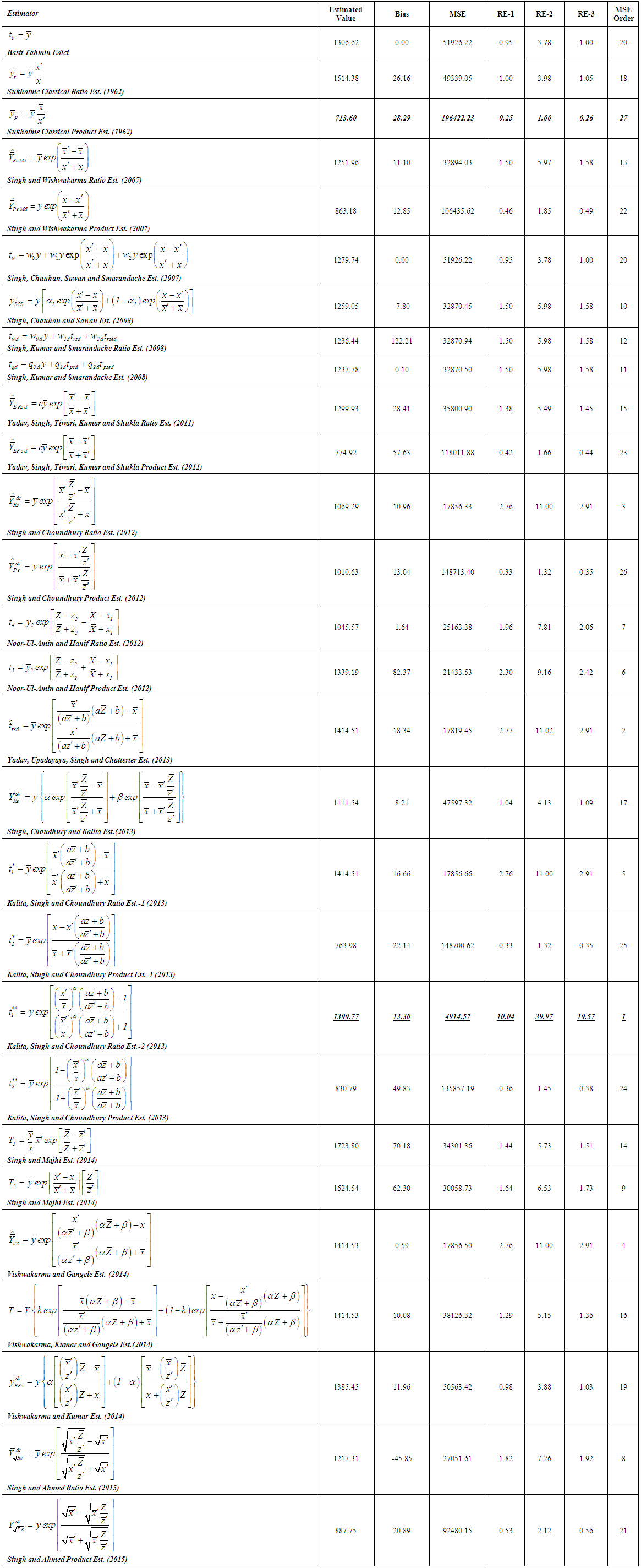 | Table 6. Bias, MSE and RE Values of Some Proposed Exponential Mean Estimators in Two Phase Sampling |
5. Results
- In this study, exponential type mean estimators in two phase sampling method are investigated. The estimators proposed at various times in the literature search are the subject of the study, the theoretical proofs are made, and the Estimator, Bias and MSE equations are derived.In order to determine the efficiencies of the proposed estimators, data on table olive production taken from Turkish Statistical Institute from the 287 regions of Muğla province in 2010 are used.Estimated value, Bias, MSE and RE values of the estimators are calculated. When these values are examined, it is seen that "Kalita, Singh and Choundhury Ratio Estimator-2" has the lowest MSE value (4914.57) and therefore the most efficient estimator among two phase exponential mean estimators in the study. The second most efficient estimator is observed to be "Yadav, Upadayaya, Singh and Chatterter Estimator" with 17819.45 MSE value.It is also observed that the estimator that predicts the variable Y with the least efficiently is the "Sukhatme Classical Product Estimator" with 196422.23 MSE value.In the next step of this study, it is planned to propose new estimators or families of estimators that yield better results than the estimators available in the literature in the two phase sampling.
ACKNOWLEDGEMENTS
- We are thankful to Scientific Research Unit of Muğla Sıtkı Koçman University for their financial support and for providing necessary guidance concerning projects implementation.
 Abstract
Abstract Reference
Reference Full-Text PDF
Full-Text PDF Full-text HTML
Full-text HTML